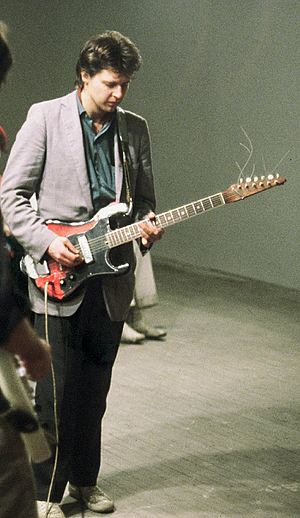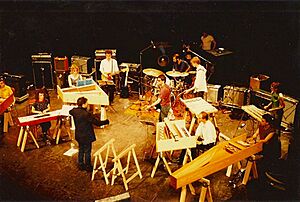Glenn Branca facts for kids
Quick facts for kids
Glenn Branca
|
|
|---|---|

Glenn Branca performing at Hallwalls in the 1980s
|
|
| Born | October 6, 1948 Harrisburg, Pennsylvania, U.S.
|
| Died | May 13, 2018 (aged 69) |
| Occupation | Composer, musician, luthier, playwright |
Glenn Branca (born October 6, 1948 – died May 13, 2018) was an American experimental composer, guitarist, and creator of special musical instruments. He was known for using loud sounds, different ways of tuning guitars, repeating musical ideas, long, continuous sounds, and the harmonic series (which are natural musical notes that vibrate together). Branca was a key figure in music styles like no wave, totalism, and noise rock. He received an award from the Foundation for Contemporary Arts in 2009.
Contents
Glenn Branca's Musical Journey
Early Years: 1960s and 1970s
Glenn Branca was born in Harrisburg, Pennsylvania. He started playing the guitar when he was 15 years old. He also enjoyed making sound art pieces by combining different tape recordings. After attending York College of Pennsylvania for a short time, he formed a cover band called The Crystal Ship in 1967.
In the early 1970s, Branca studied theater at Emerson College in Boston. He later moved to London in 1973. When he returned to Boston in 1974, he met John Rehberger. Together, they started an experimental theater group called Bastard Theatre in 1975. They created music and theater shows, with all the music being original compositions by Branca or Rehberger. The actors also performed the music live.
Moving to New York: Late 1970s and 1980s
In 1976, Branca moved to New York City to continue his work in experimental theater. However, he soon decided to form a band instead. He called his first band the Static, which later became Theoretical Girls. Branca put up posters to find band members.
His band played their first show at Franklin Furnace Archive. Later, the group reformed with Wharton Tiers as the drummer. Branca also helped record other bands and sometimes performed with Rhys Chatham's Guitar Trio. This experience was very important for his own music style. In 1982, Branca started his own record label, Neutral Records. He released early records by the famous New York band Sonic Youth.
In 1978, Branca was part of the start of the No Wave music movement. He played in a five-night music festival at Artists Space. This festival showed off many new and experimental bands from New York City.
In the early 1980s, Branca released his first album under his own name, called Lesson No. 1. He also created longer pieces for groups of electric guitars, like The Ascension (1981).
Soon after, he began writing symphonies for orchestras made of electric guitars and drums. These symphonies mixed loud, industrial sounds and microtonality (music with notes between the usual notes) with complex math and spiritual ideas. For his Symphony No. 3 (Gloria) (1983), he started to focus on the harmonic series. He believed this natural musical structure was important for all music and human activities.
Many famous musicians played in Branca's group during this time. These included Thurston Moore and Lee Ranaldo from Sonic Youth, Page Hamilton from Helmet, and members of Swans.
Creating Unique Musical Instruments
To explore the harmonic series even more, Branca built several electrically amplified instruments that he invented himself. This helped him expand his musical groups beyond just guitars. Some of these instruments were third bridge zithers, which he called harmonics guitars.
He also built instruments with many strings that he called "mallet guitars." These were played with drumsticks, like percussion instruments. He also made electric cymbaloms with an extra bridge to create special resonating sounds. You can see many of these unique instruments in the DVD Glenn Branca - Symphonies 8 & 10 - Live at The Kitchen.
Later Works: 1990s to 2018
In the early 1990s, David Baratier tried to show Branca's teaching style in a film called They Walked in Line. In September 1996, The Glenn Branca Ensemble performed at the opening of the Aarhus Festival in Denmark. Important people, including the Queen of Denmark, were in the audience.
Starting with Symphony No. 7, Branca began writing music for a traditional orchestra, but he still used the electric guitar in his work. Branca also played duets (music for two performers) with his wife, Reg Bloor, using very loud guitars.
On June 13, 2001, he conducted his 13th symphony for 100 electric guitars at the base of the World Trade Center in New York City. This was less than three months before the center was destroyed in the September 11 attacks. Since then, his 100-guitar piece has been performed in many cities across the U.S. and Europe. In 2008, he wrote his 14th Symphony, called The Harmonic Series, which is played by a traditional orchestra.
Branca received several awards for his music compositions, including grants from the Foundation for Contemporary Arts and the National Endowment for the Arts. In 2010, his 1981 album The Ascension was re-released. Branca also wrote a new piece called The Ascension: The Sequel, which came out the same year. This new music led to more interest in his work and performances at major festivals.
In October 2014, Branca introduced Ascension Three and toured with his ensemble in Europe. His piece The Light (for David) for four guitars, bass, and drums, was first performed in October 2016 in Brooklyn.
His Passing
Glenn Branca passed away on May 13, 2018, at the age of 69. His wife, Reg Bloor, announced that he died from throat cancer.
Discography
Albums
- The Ascension (1981)
- Who You Staring At? (split with John Giorno (1982)
- Symphony No. 3 (Gloria) (1983)
- Symphony No. 1 (Tonal Plexus) (1983)
- Symphony No. 6 (Devil Choirs at the Gates of Heaven) (1989)
- Symphony No. 2 (The Peak of the Sacred) (1992)
- The World Upside Down (1992)
- Symphonies Nos. 8 & 10 (The Mysteries) (1994)
- Symphony No. 5 (Describing Planes of an Expanding Hypersphere) (1995)
- Symphony No. 9 (L'eve Future) (1995)
- Empty Blue (with Tony Oursler) (2000)
- Indeterminate Activity of Resultant Masses (2006)
- The Ascension: The Sequel (2010)
- Symphony No. 7 (Graz) (2010)
- Symphony No. 13 (Hallucination City) For 100 guitars (2016)
- The Third Ascension (2019)
Singles
- "Acoustic Phenomena" (1983)
- "Symphony No. 9 (L'eve Future)" (1995)
EPs
- Lesson No. 1 (1980)
- Edmond (1986)
Live albums
- Ensemble - Live at Primavera Sound 2011 (2011)
Compilations
- Songs '77–'79 (1995)
- Selections From the Symphonies (For Electric Guitars) (1997)
Music Videos
- Glenn Branca - Symphonies 8 & 10 - Live at The Kitchen (DVD)
See also
 In Spanish: Glenn Branca para niños
In Spanish: Glenn Branca para niños
- Mudd Club
- Minimalism (music)
- Tier 3
- New wave music
- No Wave Cinema
- No wave
- Noise Fest
- Experimental musical instrument
- Noise music
- List of noise musicians
- Post-punk



